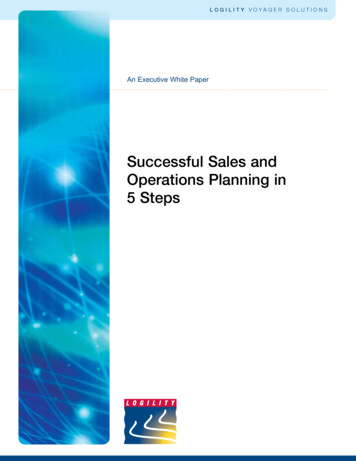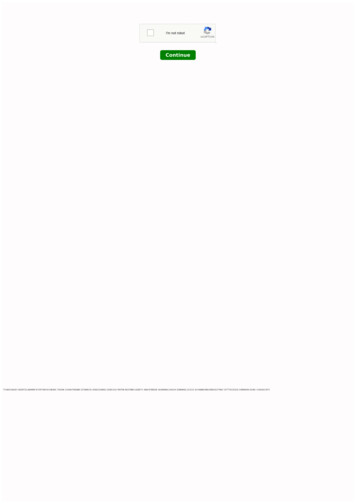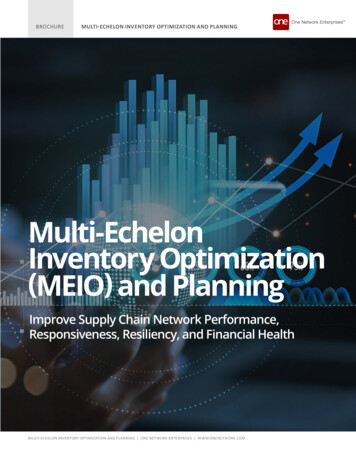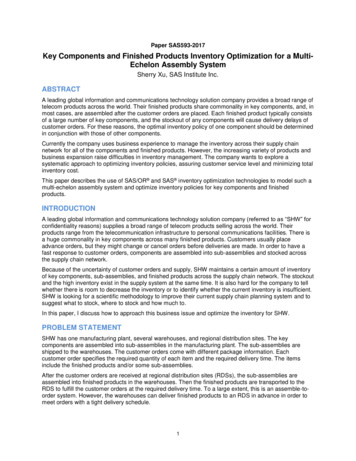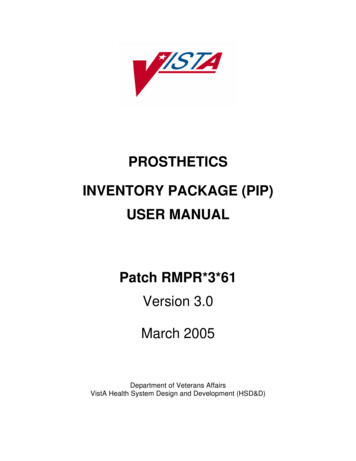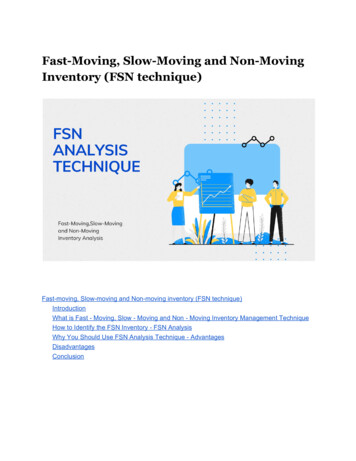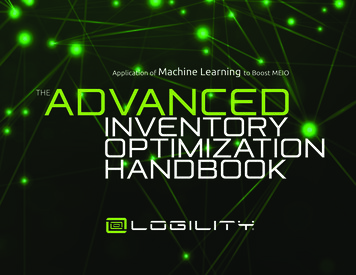
Transcription
Application of MachineLearning to Boost MEIOADVANCEDINVENTORYTHEOPTIMIZATIONHANDBOOK
WHYINVENTORYOPTIMIZATION?Today’s supply chains move at a ferocious pace fueledby multiple data streams from both internal andexternal enterprise systems, social networks, syndicatedstreams, Internet of Things (IoT) and more. Advancesin machine learning help transform this data to betterpredict customer needs, identify trends and deliver amore synchronized supply chain from product conceptto customer availability.28Inventory Optimization (IO) can have a huge financialIncrease ininventory turns t by freeing up working capital while boostingservice and minimizing inventory.Harnessing the insights of multiple data streams, IOdetermines where and how much stock to hold to meeta designated service level while complying with specificinventory policies. Through sophisticated machinelearning algorithms, IO makes stocking recommendationsto satisfy these needs.2
THE LARGE OPPORTUNITY FORINVENTORYOPTIMIZATIONMulti-echelon InventoryOptimization (MEIO) goes astep further to optimize stocklocations and amounts across allsites and nodes in a supply chainnetwork. The right MEIO approachautomates the stocking andreplenishment process as well asenables rich scenario analysis toautomatically analyze tradeoffsbetween costs and service levels.It also uses machine learning toidentify stocking patterns forseasonal products or new productintroductions. Through robustvisualizations, MEIO dashboardsand event driven notifications helpimprove usability, user adoptionTypical Unavailable vs. Optimizable 0%5%TotalInventoryIn Transit“Push”4%3%Pre-built and Unsellable OptimizablePromotionalInventorySource: Logilityand user efficiency.This e-book explains the importance of IO and MEIO strategies to help minimize costsand reduce risk while meeting customer service requirements, and provides examplesof how to build these capabilities at your company.3
MACHINE LEARNINGTO BOOST MEIOEFFECTIVENESSMachine learning has the ability to automatically learn to improveyour planning outcomes. Advanced MEIO solutions can use multiplealgorithms to determine the best inventory investment targetsbased on demand characteristics, service level goals and availablebudget.For example, Logility Voyager Solutions use machine learning toautomatically select the best inventory policy for each item acrossa company’s portfolio considering demand characteristics rangingfrom high volume to sporadic. This automation through artificialintelligence (AI) enables you to accelerate your ability to respond tochanging market conditions.4
THE TWO LEVERS OFINVENTORYOPTIMIZATIONInventory Optimization uses two powerful performance levers: working capital and servicelevels. Through the effective use of each lever, you can free trapped working capital whileimproving service levels (which can result in increased market share).Multi-echelon Inventory Optimization (MEIO) uses proven machine learning and algorithmicoptimization to accurately model inventory flows through the interdependent stages andlocations of a supply chain, and analyzes historical behavior under all conditions. The digitaltwin of your physical network helps create an optimal configuration of inventory requirementsand locations adequate to handle any degree of demand and supply uncertainty, seasonality,etc., while achieving desired service levels for minimum cost.In addition to identifying the causes and types of excess stock held at various locations, MEIOrecommends specific strategies for postponing inventory at earlier stages of manufacturingand distribution processes. Postponement can take two forms: Pooling finished goods inventory to meet aggregated customer demand streams withless waste (lower obsolescence rate). Buffering work-in-progress at crucial points before costly value-add manufacturingsteps. This reduces costs and increases flexibility.5
HighInventory Levels in EFFICIENTFRONTIERTODAYPHASE 1PHASE 2LowPHASE 3Source: Logility90%Service Level99.8%Overall, by modifying stock buffers(lowering some, raising others)and revamping policies and targetsaround the supply chain—all drivenby actual supply and demandhistory—a solid MEIO programcan create reductions of 10%30% in total inventory, freeingmillions in working capital that hasbeen trapped in excess stock andcarrying costs. That’s one side ofthe equation.The other side involves the natural trade-off between service level and inventory cost. The trade-off relationship formsa curve called the “efficient frontier.” The curve shows that, for any status quo, it will always cost more to achieve higherservice levels. But phased MEIO initiatives can change the status quo, creating a series of new curves that deliver anydesired service level at less cost than the former state allowed.6
REMOVING BARRIERS TOINVENTORYOPTIMIZATIONSupply chain executives worldwide face an ongoing dilemma: improve customer service levels but don’tcreate excess or obsolete inventory at the same time.It’s a double-edged sword for supply chain performance. Because of variability in demand and supply,increasing customer service levels can lead to higher levels of safety stock. Improving cash flow byindiscriminately reducing working capital dollars can result in slashing the wrong inventory, resulting inlower customer service levels.While many supply chain teams have conducted IO initiatives to raise service levels while loweringinventory cost, others worry that they won’t be successful in the effort.TWO COMMON BARRIERSTwo common barriers often prevent an organization from reaping IO benefits: TECHNOLOGY: Success is often undermined by reliance on limited tools (such as modules builtinto, or bolted onto, existing ERP systems) or inadequate ones (e.g. error-prone, hard-to maintainspreadsheets). These tools are unable to effectively analyze and model the required amount of inventory. COMPLEXITY: An internal perception that understanding and implementing proven mathematicaltools and business processes in order to streamline the creation of optimal inventory policies and targetsis too difficult for the team to take on.Advances in machine learning allow you to leverage artificial intelligence to automate scenario analysis,boost visibility and measure your inventory performance.Overcoming these barriers is easier than you think. Companies that embrace IO, either at a single stage oracross their full, multi-echelon network, achieve on average a 28% increase in inventory turns.7
THREE-STEPAPPROACHAA simple three-step approach can remove barriers to achieving asuccessful IO initiative.First, assess your organization’s capabilities from these perspectives:1. ASSESSCAPABILITY Inventory form, function and performance Business process and inventory management expertise Technology and organizational readinessUnderstanding your current state on these critical dimensions laysthe foundation for a solid business case that can deliver real-worldbenefits.2. BUILD ANDSUSTAINSecond, create a future state, IO capability—process, technology,organization—that provides your supply chain team with aroadmap to success.Finally, continue to drive fundamental strategic changes thatcreate greater resiliency and agility throughout the supply chainand establish a cycle of continuous improvement for years.3. DRIVESTRATEGICVALUE8
““Logility Voyager Inventory Optimization gives us the visibilitywe need across our entire supply chain.”Maegan HuberForecasting and Inventory Optimization Supervisor, Ashley FurnitureVIDEOSUCCESS STORY:Ashley Furniture Designs the Perfect Orderwith Inventory OptimizationAshley Furniture is the third largest home furnituremanufacturing company providing case goods, mattresses,upholstered goods and home accessories that are sold bymore than 6,000 retail partners.ChallengeAshley Furniture needed to fuel profitable growth whilecreating a customer-first experience by improving its perfectorder index with fast and efficient delivery without increasingsafety stock.SolutionAshley Furniture deployed Logility Voyager Solutions to helpright-size inventory across its global supply chain network andreduce safety stock.The Bottom Line Improved customer satisfaction Expanded visibility and planning throughout theglobal supply chain Reduced safety stock Optimized inventory at the item level Activated management by exception so biggestissues get first attention Avoided the need for additional distributioncenter space9
THE TOP THREEAREAS OF IMPACT1) TACTICAL & STRATEGIC INVENTORYMODELINGTactical modeling compares actual demand to forecast,and actual receipt of goods to the plan for each SKU.Tactical modeling identifies forecast accuracy and safetystock issues. Adding historical forecast accuracy into theequation enables predictive service level calculations. Thisfact-based approach to inventory targets allows you toright-size inventory by SKU.To answer more difficult questions, such as where tomake or stock products or the impact of distribution ormanufacturing facility closures or openings, use strategicinventory modeling. It can provide quick, side-by-sidescenario analysis to help make the right decisions.2) DEMAND FORECASTING ACCURACYMEIO enables timely answers to complex “what-if”scenario assessments including impacts of channelchanges and stocking policies across a complex andvolatile unified commerce global distribution network.MEIO users are more likely to boost forecast accuracy tofurther synchronize inventory alignment.3) INVENTORY REPLENISHMENT STRATEGIESImproving inventory replenishment strategies includepostponement strategies, cycle time and supplierimprovements, and changes to replenishment parameters.The addition of a formal MEIO platform can help pinpointwhich products are susceptible to supply issues so thatroot cause and corrective action can be applied.10
CHECKLISTIf your organization is considering aninventory optimization initiative, considerthese points:üüüüüINNOVATION—Ensure your solution provider harnesses the power of machine learning and artificial intelligenceüüRISK AVERSION—The right IO/MEIO approach can do more than deliver better service levels. It can also make yourto drive automation and help your company accelerate market response.USABILITY—Choose a solution that will empower users across different areas of your business to automate routineanalysis and deliver more value to the bottom line.TACTICAL TARGET SETTING—When setting tactical inventory targets on an ongoing basis, make sure you canautomatically characterize demand and uncertainty, both in lead time and in the demand signal.FLEXIBILITY—Some inventory cannot be statistically modeled. Make sure the solution you select can set smartinventory parameters for your most problematic SKUs as well as your fast movers.SUPPLY CHAIN MASTER DATA MANAGEMENT—Leveraging your enterprise data for strategic and tacticalanalysis is a major consideration. Select a software provider who can simplify the process, leverage artificial intelligenceto boost data quality and offer a powerful integration platform with little or no customization required.C-Level team happy by identifying and mitigating risk and freeing valuable working capital.STRATEGIC MODELING—Once tactical processes are in place, turn your efforts to year-over-year improvements.Leverage tactical and strategic planning capabilities to perform comprehensive analytics across your supply chain forongoing business insight.11
CONCLUSIONThe benefits of both Inventory Optimization (IO) and Multi-echelonInventory Optimization (MEIO) are well established by hundreds ofcompanies of all sizes in industries ranging from consumer products tolife sciences, high technology to process and discrete manufacturing.Leading organizations have shown that right-sizing inventorybuffers and restructuring where and how inventory is held can drivepowerful financial benefits and adds tremendous value to the Sales &Operations Planning (S&OP) process. Inventory Optimization providesa knowledge platform for better decision-making and enablesorganizations to use inventory as a lever for balancing supply anddemand.This platform also recommends where and how to hold inventoryacross all tiers of the value chain. IO and MEIO initiatives typicallyreduce inventory by 10-30% while improving service levels, resultingin dramatically improved profitability and happier customers.Significant recurring benefitscan include: Lower working capitalReduction in logisticscost burden Savings from decreasedobsolescence Revenue uplift from fewerpermanently lost sales orders12
ABOUT LOGILITYAccelerating the digital supply chain from product concept to customerdelivery, Logility helps companies seize new opportunities, sense and respondto changing market dynamics and more profitably manage their complexglobal businesses. The Logility Voyager Solutions SaaS-based platformleverages an innovative blend of artificial intelligence (AI) and advancedanalytics to automate planning, accelerate cycle times, increase precision,improve operating performance, break down business silos and delivergreater visibility.To learn how Logility can help you make smarter decisions faster, visitwww.logility.com.Worldwide Headquarters 800.762.5207United Kingdom 44 (0) 121 629 7866Visit our library of educational materials including white papers, webcastreplays, customer videos and more. Logility, Inc. 2019. All rights reserved. Logility is a registered trademark and Logility Voyager Solutionsand Logility Voyager Inventory Optimization are trademarks of Logility, Inc.
The benefits of both Inventory Optimization (IO) and Multi-echelon Inventory Optimization (MEIO) are well established by hundreds of companies of all sizes in industries ranging from consumer products to life sciences, high technology to process and discrete manufacturing. Leading organizations have shown that right-sizing inventory


